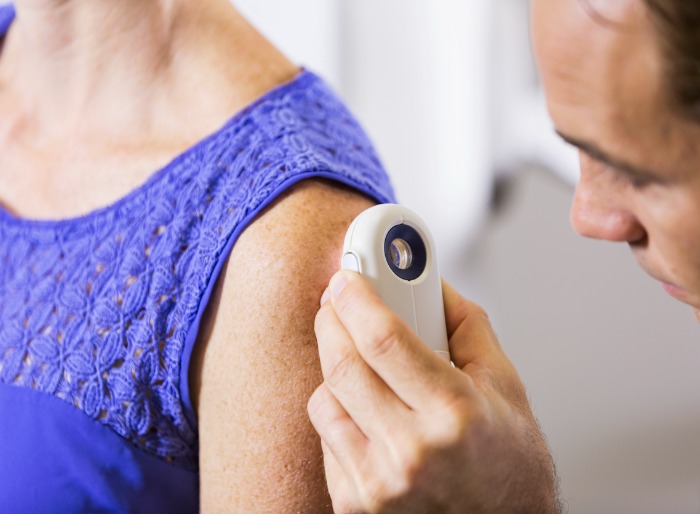Granuloma annulare is a long-lasting skin condition that may affect individuals at any age. This skin disease is relatively common, benign, and presents in five main types. If you have bumps or ring-shaped lesions on your skin that last for more than several weeks, you may require granuloma annulare treatment from our Gainesville dermatologists at Dermatology Associates. Dermatology Associates provides patients with the highest-quality medical dermatology treatments through individualized treatment plans with compassionate care and state-of-the-art dermatologic equipment. Whether you need help managing your skin condition or want to improve the overall health of your skin, our dermatologists will help you find the right treatment for your needs. Schedule a dermatology appointment today.

What Is Granuloma Annulare?
Granuloma annulare is a common skin condition characterized by a ring, patterned, raised rash or lesions (bumps). Of the five types of granuloma annulare, the most common type generally affects the hands and feet of young adults and children. This condition’s cause is unknown, and other variations are found in patients of all ages. Certain risk factors, such as minor skin injuries and medications may trigger this condition. This condition is often seen in otherwise healthy individuals, though it is sometimes associated with diabetes or thyroid disease, among other health conditions. Granuloma annulare is not contagious and is not usually painful, though it can make an individual feel self-conscious. In cases where granuloma annulare becomes a chronic, or long-term condition, it can cause significant emotional distress.
What Causes Granuloma Annulare?
Granuloma annulare causes are unknown, though it may be a delayed hypersensitivity reaction to a component of the dermis or a reaction pattern to multiple triggers. Triggering events can include different factors, such as events that include skin infections, skin infestations, and certain types of skin trauma.
Granuloma Annulare Risk Factors
Though it isn’t clear what causes this condition, certain links are made between granuloma annulare and stress, among other risk factors. In some cases, granuloma annulare may be triggered by the following factors.
- Animal Or Insect Bites
- Hepatitis Or Other Infections
- Tuberculin Skin Tests
- Sun Exposure
- Vaccinations
- Minor Skin Injuries
- Drugs
What Are The Clinical Features Of Granuloma Annulare?
Granuloma annulare can occur anywhere on the body and may, occasionally, be widespread. In some cases, granuloma annulare can cause no symptoms, though affected areas may be tender to the touch. The plaques produced by this condition may change in shape, size, and position over time. There are five main types of granuloma annulare, which we have listed below.
Localized Granuloma Annulare
The most common type of granuloma annulare, localized granuloma annulare, primarily affects children and young adults. It is characterized by one or more skin-colored bumps that form rings in the skin over the joints, such as the knuckles. The surface of the bumps is smooth, and the center of each ring is depressed. This form of granuloma annulare usually affects the fingers, backs of the hands, on top of the feet or ankles, and over the elbows. Annular rings can present alone or in multiples and grow outwards.
How Is Granuloma Annulare Diagnosed?
Granuloma annulare is usually diagnosed clinically by a dermatologist because of its characteristic appearance. However, the diagnosis may not be obvious, and other conditions may be considered. Your dermatologist will examine your skin to determine whether you have granuloma annulare. Your doctor may also take a skin biopsy, or a sample of your skin, to confirm your diagnosis and to rule out other diseases or conditions.
Granuloma Annulare Treatment
For many individuals, granuloma annulare will go away on its own. The condition may disappear completely within 2-4 years. However, the rash can recur once it has resolved in some patients. If granuloma annulare causes large rashes or large, deep lumps under your skin, clinical treatment for granuloma annulare may be necessary. In most cases, the primary purpose of treatment is to help control symptoms of granuloma annulare, such as itching or pain. Treatments may speed up the time it takes for your rash to fade.
- Medications. Certain prescription medications, such as corticosteroids, isotretinoin, or tacrolimus, can help clear your skin by reducing inflammation. Medications may be applied directly to the skin or given as an injection.
- Light Therapy. PUVA therapy uses psoralen, a drug taken orally or given as a soak. Then, doctors expose the skin to UVA light. Psoralen makes the skin more sensitive to light and UV light can help slow the growth of skin cells.
- Cryotherapy. Using specialized dermatologic equipment, the doctor freezes a portion of the skin affected by granuloma annulare. Cryotherapy tries to stop the continued growth of skin patches or lesions from granuloma annular, especially with small isolated lesions.

What Is The Outlook For Granuloma Annulare?
There is no way to predict the cause of granuloma annulare, however, treatment may help you find effective relief from symptoms. In many cases, granuloma annulare clears up on its own without treatment and leaves no trace behind. But, because granuloma annulare is a chronic disease, the resulting lesions often return in the same place. Recurring problem areas often disappear quicker than areas with first-time rashes.